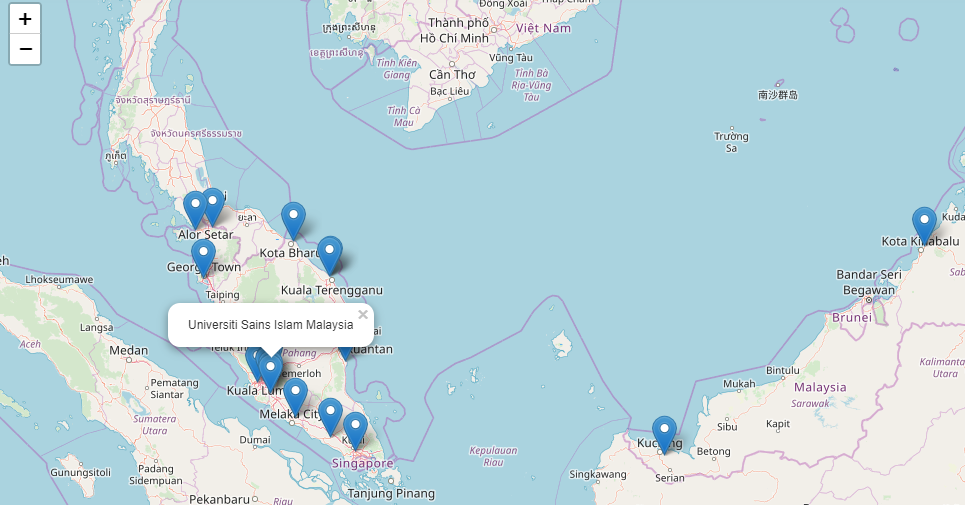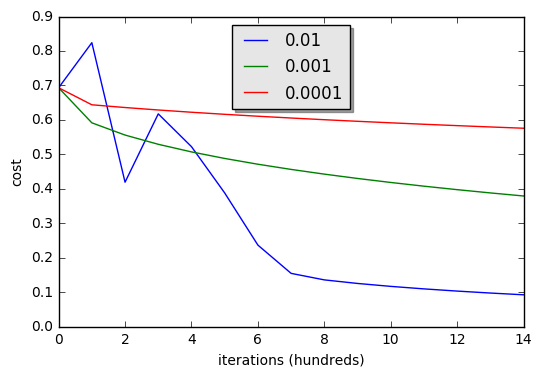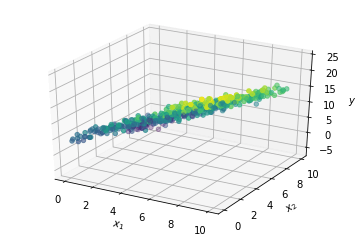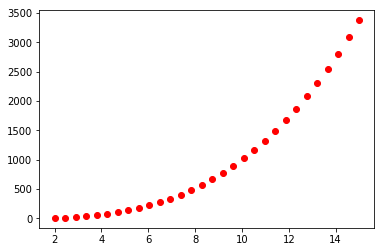Basic Concepts
# let's first import all the libraries needed for this tutorial
import pandas as pd
import numpy as np
import matplotlib.pyplot as plt
The primary data structures in pandas are implemented as two classes:
DataFrame, which you can imagine as a relational data table, with rows and named columns.
Series, which is a single column. A DataFrame contains one or more Series and a name for each Series.
day = ['Friday', 'Saturday', 'Sunday', 'Monday', 'Tuesday', 'Wednesday', 'Thursday' ]
first_sell = [100, 120, 310, 400, 90, 29, 30]
# to merge these two list we will use zip function
flower_sell = list(zip(day,first_sell))
[('Friday', 100),
('Saturday', 120),
('Sunday', 310),
('Monday', 400),
('Tuesday', 90),
('Wednesday', 29),
('Thursday', 30)]
# Great, we have created our dataset. Let's use pandas do some magic
df = pd.DataFrame(data = flower_sell, columns=['day', 'sell'] )
# df is for dataframe
|
day |
sell |
| 0 |
Friday |
100 |
| 1 |
Saturday |
120 |
| 2 |
Sunday |
310 |
| 3 |
Monday |
400 |
| 4 |
Tuesday |
90 |
| 5 |
Wednesday |
29 |
| 6 |
Thursday |
30 |
# we just have created pandas dataframe
# let's do similar with pandas series
day = pd.Series(['Friday', 'Saturday', 'Sunday', 'Monday', 'Tuesday', 'Wednesday', 'Thursday' ])
first_sell = pd.Series([100, 120, 310, 400, 90, 29, 30])
flower_sell = pd.DataFrame({'Day': day, 'Sell1': first_sell})
|
Day |
Sell1 |
| 0 |
Friday |
100 |
| 1 |
Saturday |
120 |
| 2 |
Sunday |
310 |
| 3 |
Monday |
400 |
| 4 |
Tuesday |
90 |
| 5 |
Wednesday |
29 |
| 6 |
Thursday |
30 |
# let's add another column for 2nd sell
flower_sell['Sell2'] = pd.Series([128, 230, 120, 231, 901, 140, 41])
|
Day |
Sell1 |
Sell2 |
| 0 |
Friday |
100 |
128 |
| 1 |
Saturday |
120 |
230 |
| 2 |
Sunday |
310 |
120 |
| 3 |
Monday |
400 |
231 |
| 4 |
Tuesday |
90 |
901 |
| 5 |
Wednesday |
29 |
140 |
| 6 |
Thursday |
30 |
41 |
accessing data
0 100
1 120
2 310
3 400
4 90
5 29
6 30
Name: Sell1, dtype: int64
0 Friday
1 Saturday
2 Sunday
3 Monday
4 Tuesday
5 Wednesday
6 Thursday
Name: Day, dtype: object
flower_sell['Sell2'][0:4]
0 128
1 230
2 120
3 231
Name: Sell2, dtype: int64
6 Thursday
5 Wednesday
4 Tuesday
3 Monday
2 Sunday
1 Saturday
0 Friday
Name: Day, dtype: object
Manipulating Data
flower_sell['Total_Sell'] = flower_sell['Sell1'] + flower_sell['Sell2']
|
Day |
Sell1 |
Sell2 |
Total_Sell |
| 0 |
Friday |
100 |
128 |
228 |
| 1 |
Saturday |
120 |
230 |
350 |
| 2 |
Sunday |
310 |
120 |
430 |
| 3 |
Monday |
400 |
231 |
631 |
| 4 |
Tuesday |
90 |
901 |
991 |
| 5 |
Wednesday |
29 |
140 |
169 |
| 6 |
Thursday |
30 |
41 |
71 |
# Now we can add another column as average sell
flower_sell['average_sell'] = flower_sell['Total_Sell']/2
|
Day |
Sell1 |
Sell2 |
Total_Sell |
average_sell |
| 0 |
Friday |
100 |
128 |
228 |
114.0 |
| 1 |
Saturday |
120 |
230 |
350 |
175.0 |
| 2 |
Sunday |
310 |
120 |
430 |
215.0 |
| 3 |
Monday |
400 |
231 |
631 |
315.5 |
| 4 |
Tuesday |
90 |
901 |
991 |
495.5 |
| 5 |
Wednesday |
29 |
140 |
169 |
84.5 |
| 6 |
Thursday |
30 |
41 |
71 |
35.5 |
# Let's save this file
flower_sell.to_csv('mysell', index='False',header='Small Business')
Indexes
Both Series and DataFrame objects also define an index property that assigns an identifier value to each Series item or DataFrame row.
By default, at construction, pandas assigns index values that reflect the ordering of the source data. Once created, the index values are stable; that is, they do not change when data is reordered.
RangeIndex(start=0, stop=7, step=1)
flower_sell.reindex([2, 6, 4])
|
Day |
Sell1 |
Sell2 |
Total_Sell |
average_sell |
| 2 |
Sunday |
310 |
120 |
430 |
215.0 |
| 6 |
Thursday |
30 |
41 |
71 |
35.5 |
| 4 |
Tuesday |
90 |
901 |
991 |
495.5 |
Working with large dataset
So far we have created a small dataframe and have done
some basic operation on it. Let’s work with large amount of
data. You can downlaod any dataset with google dataset search.
I have a csv file which I have donwloaded from www.kaggle.com
We will look into this and will perform some operation in it.
# First thing first, we need to read the file
# let's specify the location
location = r'C:\Users\ICT_H\Desktop\Machine Learning\File\train1.csv'
home_data = pd.read_csv(location)
# to describe the data we can do the following command
home_data.describe()
|
Id |
LotArea |
YearBuilt |
TotalBsmtSF |
BedroomAbvGr |
YrSold |
SalePrice |
| count |
1460.000000 |
1460.000000 |
1460.000000 |
1460.000000 |
1460.000000 |
1460.000000 |
1460.000000 |
| mean |
730.500000 |
10516.828082 |
1971.267808 |
1057.429452 |
2.866438 |
2007.815753 |
180921.195890 |
| std |
421.610009 |
9981.264932 |
30.202904 |
438.705324 |
0.815778 |
1.328095 |
79442.502883 |
| min |
1.000000 |
1300.000000 |
1872.000000 |
0.000000 |
0.000000 |
2006.000000 |
34900.000000 |
| 25% |
365.750000 |
7553.500000 |
1954.000000 |
795.750000 |
2.000000 |
2007.000000 |
129975.000000 |
| 50% |
730.500000 |
9478.500000 |
1973.000000 |
991.500000 |
3.000000 |
2008.000000 |
163000.000000 |
| 75% |
1095.250000 |
11601.500000 |
2000.000000 |
1298.250000 |
3.000000 |
2009.000000 |
214000.000000 |
| max |
1460.000000 |
215245.000000 |
2010.000000 |
6110.000000 |
8.000000 |
2010.000000 |
755000.000000 |
# to see only the first part of the dataset
home_data.head()
|
Id |
LotArea |
YearBuilt |
TotalBsmtSF |
BedroomAbvGr |
YrSold |
SaleType |
SalePrice |
| 0 |
1 |
8450 |
2003 |
856 |
3 |
2008 |
WD |
208500 |
| 1 |
2 |
9600 |
1976 |
1262 |
3 |
2007 |
WD |
181500 |
| 2 |
3 |
11250 |
2001 |
920 |
3 |
2008 |
WD |
223500 |
| 3 |
4 |
9550 |
1915 |
756 |
3 |
2006 |
WD |
140000 |
| 4 |
5 |
14260 |
2000 |
1145 |
4 |
2008 |
WD |
250000 |
# You can specify how many row you want to display. By default it's 5
home_data.head(10) # I want to display 10 raw
|
Id |
LotArea |
YearBuilt |
TotalBsmtSF |
BedroomAbvGr |
YrSold |
SaleType |
SalePrice |
| 0 |
1 |
8450 |
2003 |
856 |
3 |
2008 |
WD |
208500 |
| 1 |
2 |
9600 |
1976 |
1262 |
3 |
2007 |
WD |
181500 |
| 2 |
3 |
11250 |
2001 |
920 |
3 |
2008 |
WD |
223500 |
| 3 |
4 |
9550 |
1915 |
756 |
3 |
2006 |
WD |
140000 |
| 4 |
5 |
14260 |
2000 |
1145 |
4 |
2008 |
WD |
250000 |
| 5 |
6 |
14115 |
1993 |
796 |
1 |
2009 |
WD |
143000 |
| 6 |
7 |
10084 |
2004 |
1686 |
3 |
2007 |
WD |
307000 |
| 7 |
8 |
10382 |
1973 |
1107 |
3 |
2009 |
WD |
200000 |
| 8 |
9 |
6120 |
1931 |
952 |
2 |
2008 |
WD |
129900 |
| 9 |
10 |
7420 |
1939 |
991 |
2 |
2008 |
WD |
118000 |
# how about to look at the end of our dataset. We can do so by following
home_data.tail()
|
Id |
LotArea |
YearBuilt |
TotalBsmtSF |
BedroomAbvGr |
YrSold |
SaleType |
SalePrice |
| 1455 |
1456 |
7917 |
1999 |
953 |
3 |
2007 |
WD |
175000 |
| 1456 |
1457 |
13175 |
1978 |
1542 |
3 |
2010 |
WD |
210000 |
| 1457 |
1458 |
9042 |
1941 |
1152 |
4 |
2010 |
WD |
266500 |
| 1458 |
1459 |
9717 |
1950 |
1078 |
2 |
2010 |
WD |
142125 |
| 1459 |
1460 |
9937 |
1965 |
1256 |
3 |
2008 |
WD |
147500 |
# we can visualize particular column as well
home_data.hist('SalePrice')
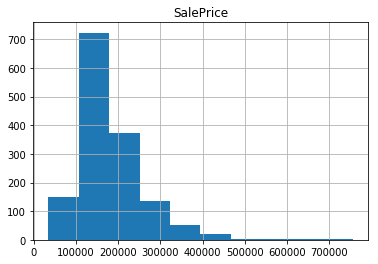
saleprice = home_data['SalePrice']
NumPy is a popular toolkit for scientific computing. pandas Series can be used as arguments to most NumPy functions:
np.log(saleprice) # to get the logarithmic value of salaprice
0 12.247694
1 12.109011
2 12.317167
3 11.849398
4 12.429216
5 11.870600
6 12.634603
7 12.206073
8 11.774520
9 11.678440
10 11.771436
11 12.751300
12 11.877569
13 12.540758
14 11.964001
15 11.790557
16 11.911702
17 11.407565
18 11.976659
19 11.842229
20 12.692503
21 11.845103
22 12.345835
23 11.774520
24 11.944708
25 12.454104
26 11.811547
27 12.631340
28 12.242887
29 11.134589
...
1430 12.165980
1431 11.875831
1432 11.074421
1433 12.136187
1434 11.982929
1435 12.066811
1436 11.699405
1437 12.885671
1438 11.916389
1439 12.190959
1440 12.160029
1441 11.913713
1442 12.644328
1443 11.703546
1444 12.098487
1445 11.767568
1446 11.969717
1447 12.388394
1448 11.626254
1449 11.429544
1450 11.820410
1451 12.567551
1452 11.884489
1453 11.344507
1454 12.128111
1455 12.072541
1456 12.254863
1457 12.493130
1458 11.864462
1459 11.901583
Name: SalePrice, Length: 1460, dtype: float64
saleprice.apply(lambda val: val > 100000)
0 True
1 True
2 True
3 True
4 True
5 True
6 True
7 True
8 True
9 True
10 True
11 True
12 True
13 True
14 True
15 True
16 True
17 False
18 True
19 True
20 True
21 True
22 True
23 True
24 True
25 True
26 True
27 True
28 True
29 False
...
1430 True
1431 True
1432 False
1433 True
1434 True
1435 True
1436 True
1437 True
1438 True
1439 True
1440 True
1441 True
1442 True
1443 True
1444 True
1445 True
1446 True
1447 True
1448 True
1449 False
1450 True
1451 True
1452 True
1453 False
1454 True
1455 True
1456 True
1457 True
1458 True
1459 True
Name: SalePrice, Length: 1460, dtype: bool
Dealing with missing data
Let’s create a pandas dataframe with missing data
name = pd.Series(['a', 'b', 'c', 'd', 'e', 'f'])
price = pd.Series([10, 20, 15])
missing_data = pd.DataFrame({'Name': name, 'Price': price})
|
Name |
Price |
| 0 |
a |
10.0 |
| 1 |
b |
20.0 |
| 2 |
c |
15.0 |
| 3 |
d |
NaN |
| 4 |
e |
NaN |
| 5 |
f |
NaN |
missing_data['Price'].isna()
0 False
1 False
2 False
3 True
4 True
5 True
Name: Price, dtype: bool
# we can fill missing values with: fillna() method
missing_data['Price'].fillna(0) # to fill with 0
0 10.0
1 20.0
2 15.0
3 0.0
4 0.0
5 0.0
Name: Price, dtype: float64
missing_data['Price'].fillna('missing')
0 10
1 20
2 15
3 missing
4 missing
5 missing
Name: Price, dtype: object
We can’t build model with missing value. There are several ways
to deal with missing value while building model. I will discuss about
it in my future post.
If you want to learn more about pandas: visit: https://pandas.pydata.org/pandas-docs/stable/cookbook.html#missing-data


